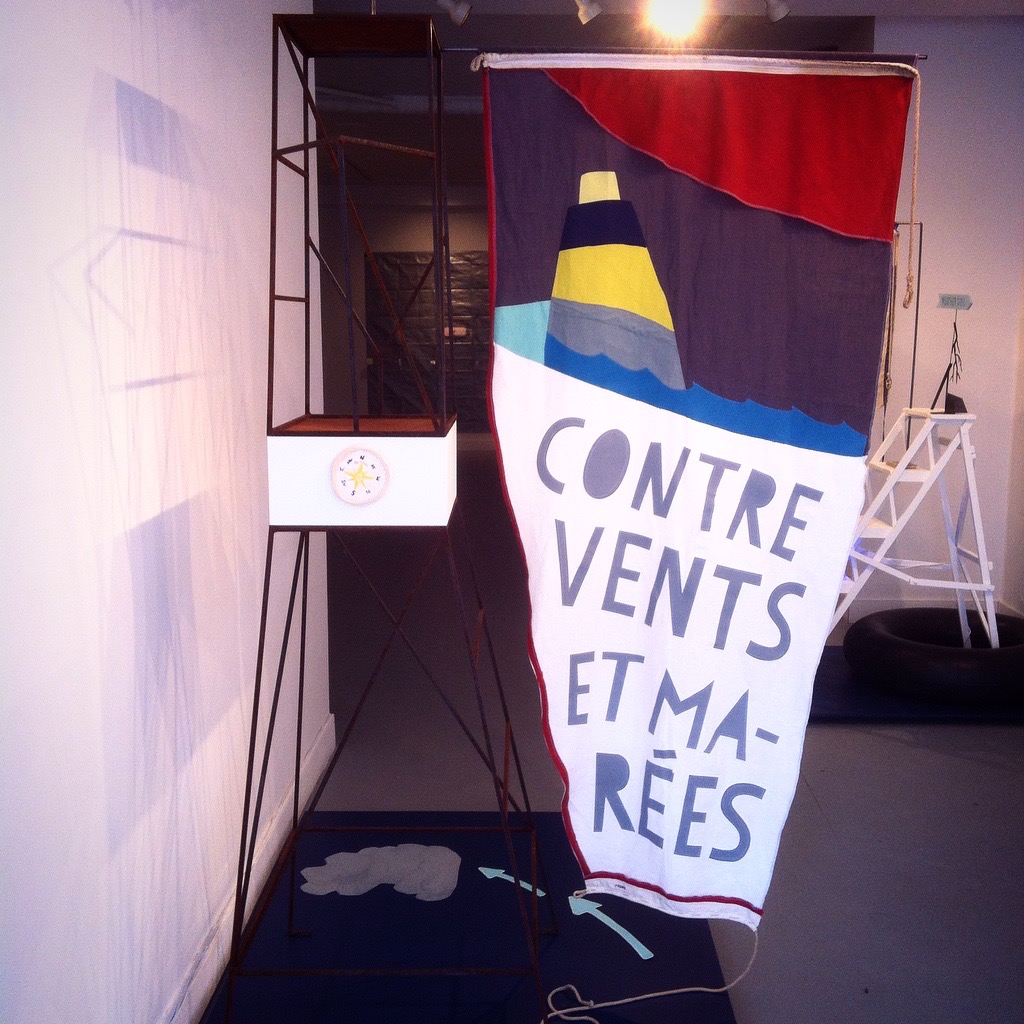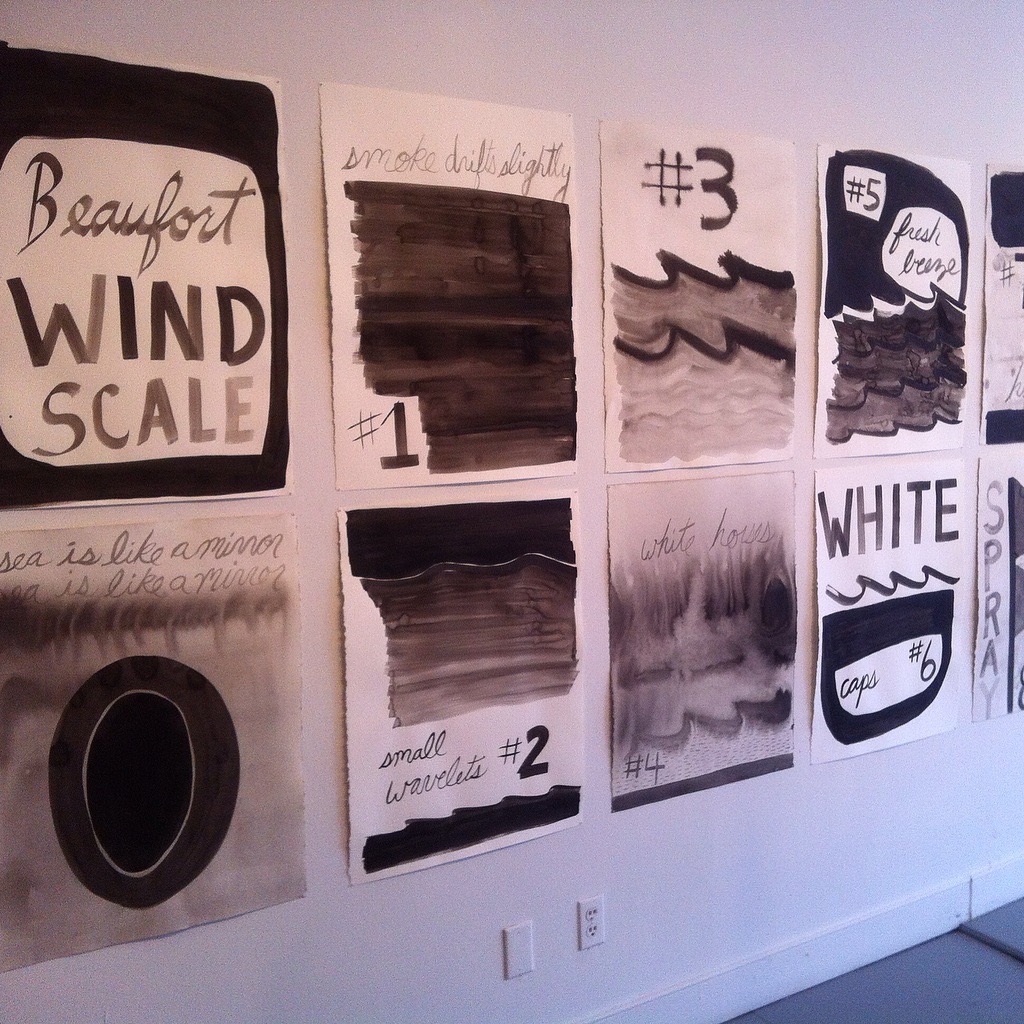Walking into the narrow space of the loop gallery, the visitor is confronted with Tara Cooper’s Contre vents et marées. The viewer is breezily welcomed into the space as the gentle whir of a stationary fan fills the ready-made sails of Cooper’s self-described “floating platforms”. The show is comprised of three large installation pieces, a combination of found objects, sculpture and ceramics related to the life of a mariner, or one who charts the ever-changing winds. Fully entering into the space means coming face to face with the central work and namesake of the exhibition, Contre vents et marées.
 Tara Cooper, Contre vents et Marées (against winds and tides), steel towers, sewn banner with screen-print, metal weather vanes, mirror, wooden platform, woodcut print, screen printed arrows, steel “North” weather balloon instruments, 2015
Tara Cooper, Contre vents et Marées (against winds and tides), steel towers, sewn banner with screen-print, metal weather vanes, mirror, wooden platform, woodcut print, screen printed arrows, steel “North” weather balloon instruments, 2015
The main component of the installation is a large metal tower, seeming to echo the lifeguard stands of days gone by. Standing atop the tower is a rusty weather vane pointing to Cooper’s hanging sail whose quilted block letters detail the title and flap carelessly in the artificial wind. Our eye is then lead to the base of the work, where two teal arrows appear on a dark blue base pointing to a paper cloud cut out. Words have a great presence in the exhibition, specifically in this work whose translation ‘against wind and tide’ is a French idiom expressing the ability to continue against all obstacles. Here Cooper’s sculptural installation reflects a certain folksy boldness.
 Tara Cooper, The Beaufort Wind Scale, ink drawings on paper
Tara Cooper, The Beaufort Wind Scale, ink drawings on paper
The opposing wall offers a respite to the artist’s more dynamic ‘floating platforms’. Instead, we are offered a series of ink drawings revolving around the Beaufort wind scale. A meteorological measurement system that correlates wind speed to observed physical conditions. These monochromatic drawings explore each of the twelve levels in Sir Francis Beaufort’s scale, detailing sea conditions at the varying stages. Tara Cooper has spent a residency in Brigus, Newfoundland with the Landfall Trust. Her stay in the Maritimes allowed Cooper to see first hand the importance of meteorology on this society’s way of life. In particular, the artist was interested in how mythology and storytelling became inescapably intertwined with the weather.
The changing tides of the gallery bring us to the second exhibition, Richard Sewell’s Compression. Comprised of three large hanging tarps, each with a series of relief elements created with duct tape and plastic objects procured from the local hardware store. Sewell, a retired professor of the visual arts, has created a complex glyphic language. The legend for each element in the composition is a meditation on how we notate and deconstruct a work of art. The catalyst for this project was the system of notation for dance, an intricate language used prior to the days of video technology to expound the details of a choreography. In a similar fashion, Sewell breaks down each component of his work, with a title and almost impenetrable description.
 Richard Sewell, stor*emRe*ox*ar*chy (storage + Rembrandt + box + hierarchy) a straight*ti*cal occurrence, polyethylene and vinyl tubing, cable-ties, screws, straight pins. Coroplast sheet: opaque, cut, braced, and/or laminated, Rubbermaid Snap Case Storage box, and wall-clip, 1994-2016
Richard Sewell, stor*emRe*ox*ar*chy (storage + Rembrandt + box + hierarchy) a straight*ti*cal occurrence, polyethylene and vinyl tubing, cable-ties, screws, straight pins. Coroplast sheet: opaque, cut, braced, and/or laminated, Rubbermaid Snap Case Storage box, and wall-clip, 1994-2016
The most eye catching component, is the “stor*emRe*ox*ar*chy (storage + Rembrandt + box + hierarchy),” where a print of Rembrandt’s self-portrait is framed and covered by a Rubbermaid plastic container. Sewell’s notation system and his decoding of art is not always easy to decipher.
Text and photo: Meghan O’Callaghan
*Exhibition information: February 27 – March 20, 2016, Loop Gallery, 1273 Dundas Street West, Toronto, (three doors west of Dovercourt). Gallery hours: Wed – Sat 12 – 5, Sun 1 – 4 p.m.

